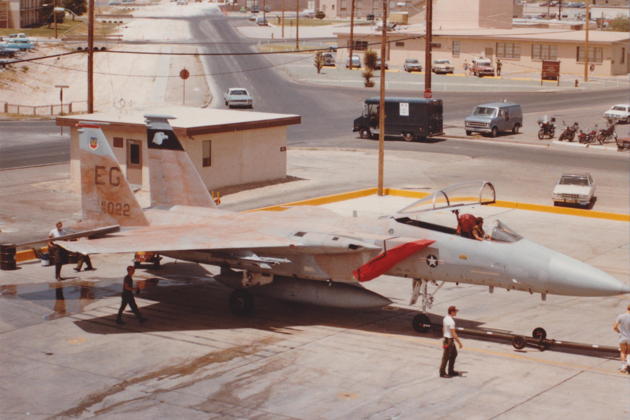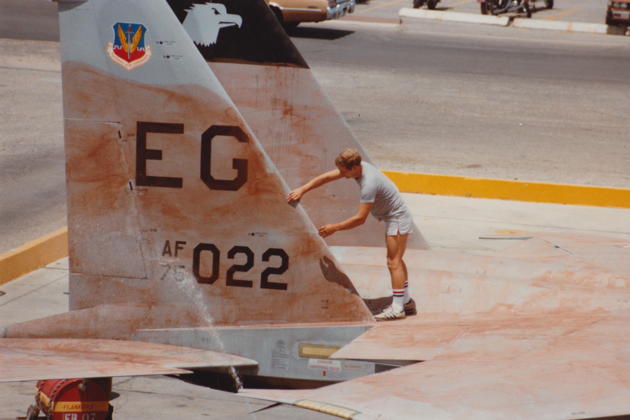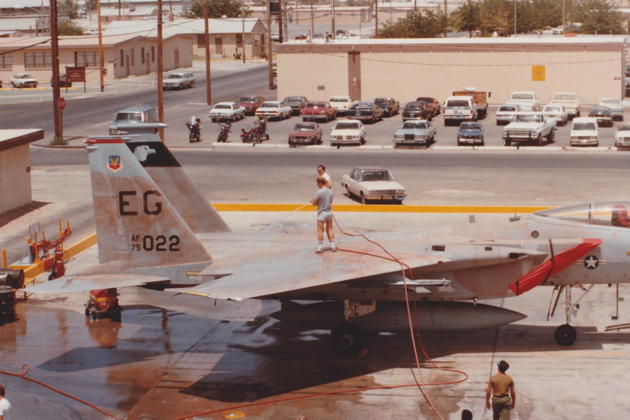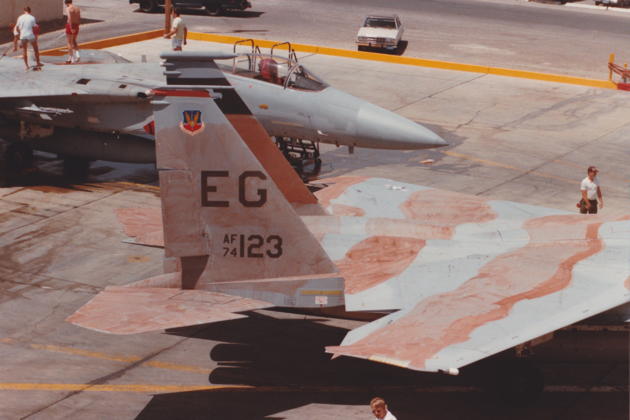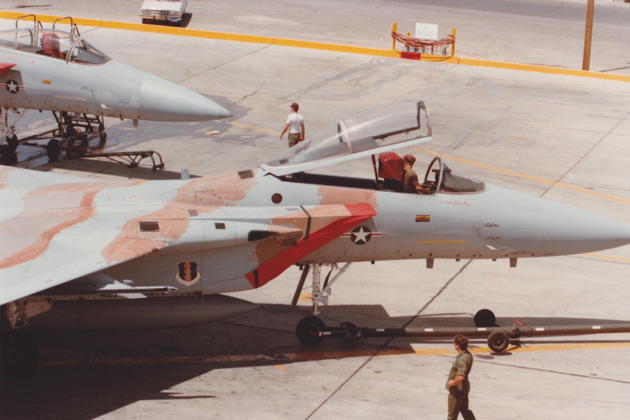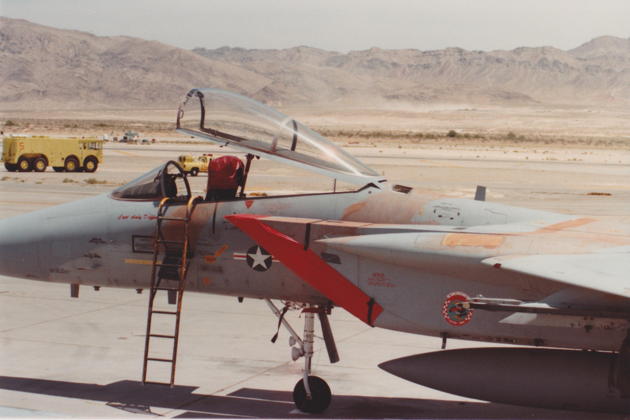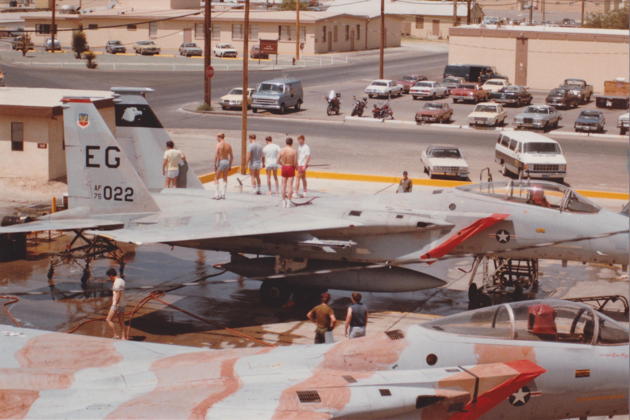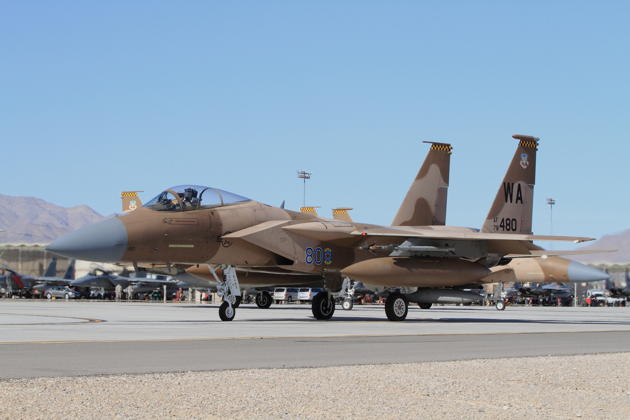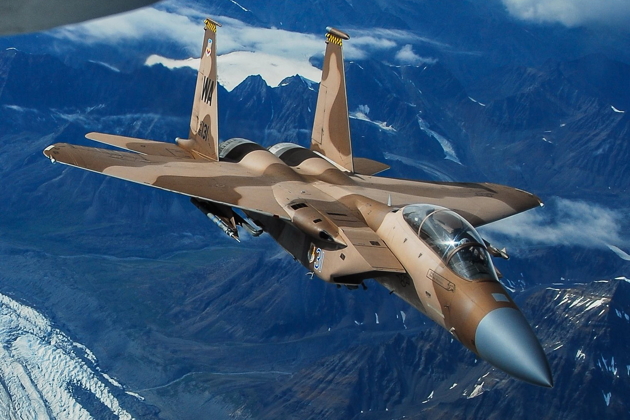FlightLog Archive
∟Aircraft Flown
Tan Eagles - Jun 1983
In the early to mid-1980s, I had THE best flying job on the planet. I was an F-15 instructor pilot and the weapons and tactics officer for the 60th Fighter Squadron, part of the 33rd Fighter Wing at Eglin Air Force Base, Florida. My job was to keep the squadron pilots up-to-date on the latest F-15 and air-to-air fighter tactics while constantly looking for ways to keep our squadron proficient and the best at our air superiority job. While we were still in the middle of the Cold War, with planning for the Soviet Union as our major threat, activities in the desert countries of South West Asia (SWA) were also influencing our planning and tactics.
In our deployment package for the squadron, we had supply of tan paint, supposedly on hand for use during a desert deployment. As the new Weapons Officer, I asked my Squadron Commander, Mike Ridnouer, if the paint had been ever been tested or demonstrated on our Eagles. It had not. We were scheduled for an upcoming deployment to Red Flag 83-4 to Nellis Air Force Base, Nevada, where we planned to hone our skills as part of a rapid deployment force exercise. I convinced the boss to let us paint two of our squadron's Eagles during our upcoming Red Flag deployment, since the Nevada ranges were a perfect simulator for desert combat deployment and a way to test the camouflage effectiveness. Although our primary Eagle tactics involved beyond visual range missile engagement, during the times we were engaged in medium or low altitude air combat, we were looking to see if there was any advantage with a temporary tan paint job in that desert environment.
I took only two large buckets from our combat deployment package, and sent them ahead to Nellis with the rest of our aircraft support gear. I recruited a number of the young lieutenants in our squadron who were enthusiastic about painting up two of our Eagles. Since I only had two buckets to work with, I decided to paint the entire top side of one aircraft, F-15A 75–022, in tan and use the remaining tan paint on an angled striped pattern with the remaining supply on F-15A 74–123.
Soon after we arrived at Nellis, we quickly applied the tan paint with brooms, brushes and sponges. The 'paint' crew were all 60 FS pilots, myself, Tom 'Tee' Jordan, Ron ‘Arlo’ Guthrie, Tom Moore, Jim Barry and Phil Gable. It was a short-term experiment, with tan paint applied on 10 and 12 June 83, painted removed (partially) 17 June 83. We definitely turned a number of heads on the first few days of Red Flag with our early successes against the aggressors with the ‘Tan Eagles’, as they were quickly named, with all the squadron pilots volunteering to fly a Tan Eagle at their first opportunity. I flew the first early flights of each of the Tan Eagles during Red Flag, and amassed a 9:0 kill ratio vs the F-5 Aggressors. All those kills were not completely due my camouflage and their later acquisition of me in close-in fights, but I felt it did help in a couple of engagements. During our debriefs at the end of Red Flag, some the Aggressor F-5 pilots claimed it worked too well, and they were getting killed too many times by the Tan Eagles!
An Air Force photographer took a number of photos of the Tan Eagles airborne from the back of KC-135 tanker while we were refueling, but they were never released to us. The resident 422 Test and Evaluation Squadron (TES) at Nellis did note it was their job to test and evaluate new tactics and paint schemes, not the operational squadrons. Later in the F-15's career, Eagles were employed as aggressors, and sported both tan and blue camouflage schemes, more to mimic threat colors than a primary use as camouflage.
Our boss said it was my job to clean up the two Tan Eagles before we flew back to Eglin, so I recruited my bunch of lieutenants and had our maintenance team tow the birds to the Nellis wash rack on 17 June. Although we scrubbed and scrubbed and tried to wash off the paint before deploying home, the desert sun had done a pretty good job of baking in the tan paint. One of my lieutenants, Tom 'Tee' Jordan, commented years later when reviewing the cleanup photos "I remember trying to wash it off. Scrub, cleaners, detergents. Nothing successful. I cursed the idea!!" We got the majority of the tan paint off, but both jets looked pretty gnarly, and both 75-022 and 74-123 got in an early rotation for a new paint job when back at Eglin. At least we 'exercised the option', felt it was useful, and still retained the paint in our deployment kit.
Our extensive training and pilot proficiency at the 33rd Fighter Wing, combined with the great performance of the F-15, contributed well to the future success of the 33rd Fighter Wing in Desert Storm, where the wing amassed a stellar 16-0 kill ratio against the threat MiGs, Sukhois and Mirages, adding to the overall lifetime 104-0 kill ratio of the Mighty Eagle. I’m very glad to be a small part of the Eagle legacy.
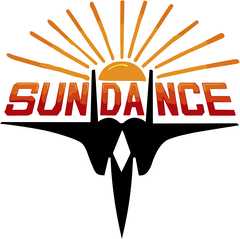 KASPRZYK
KASPRZYK